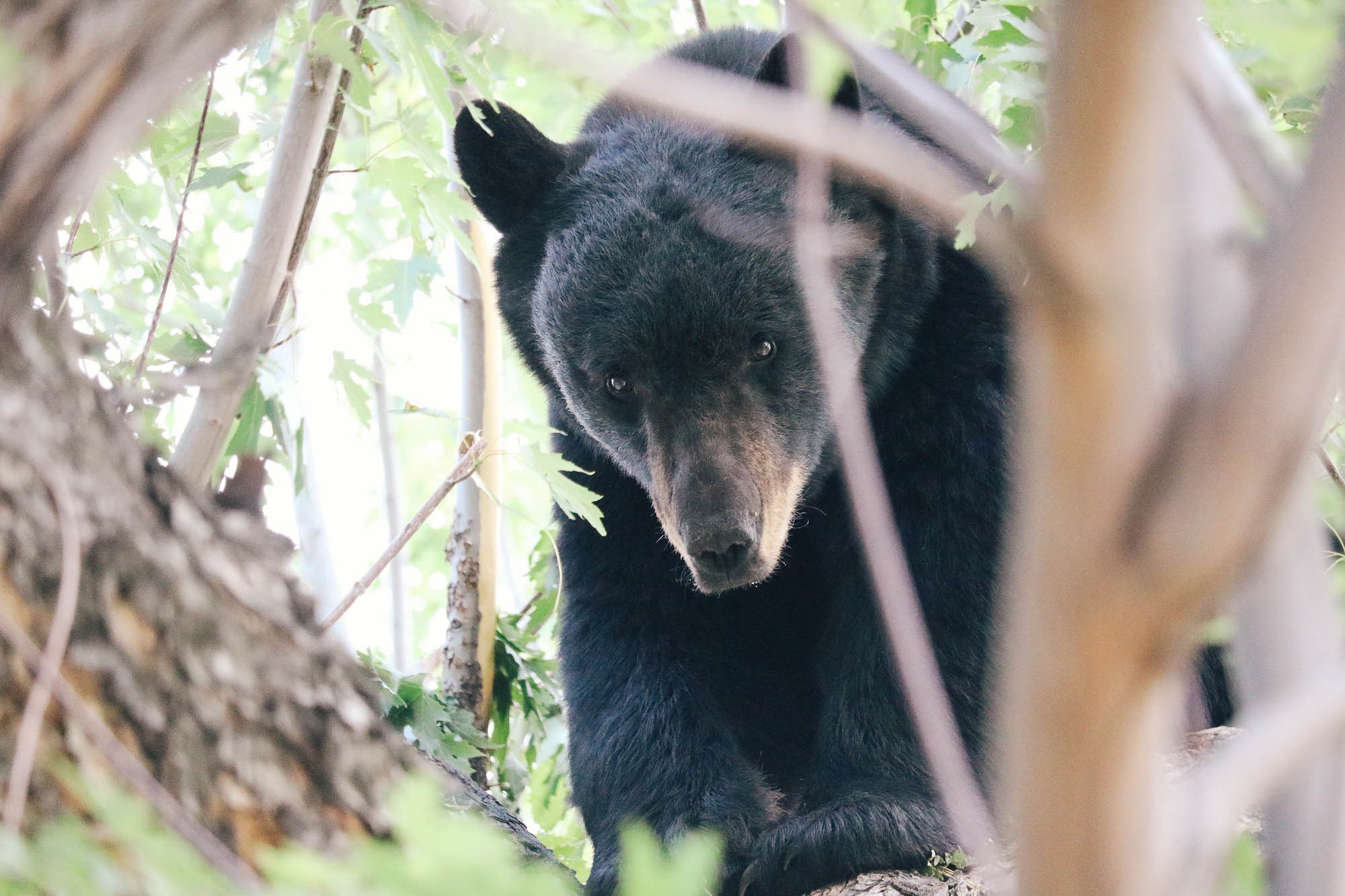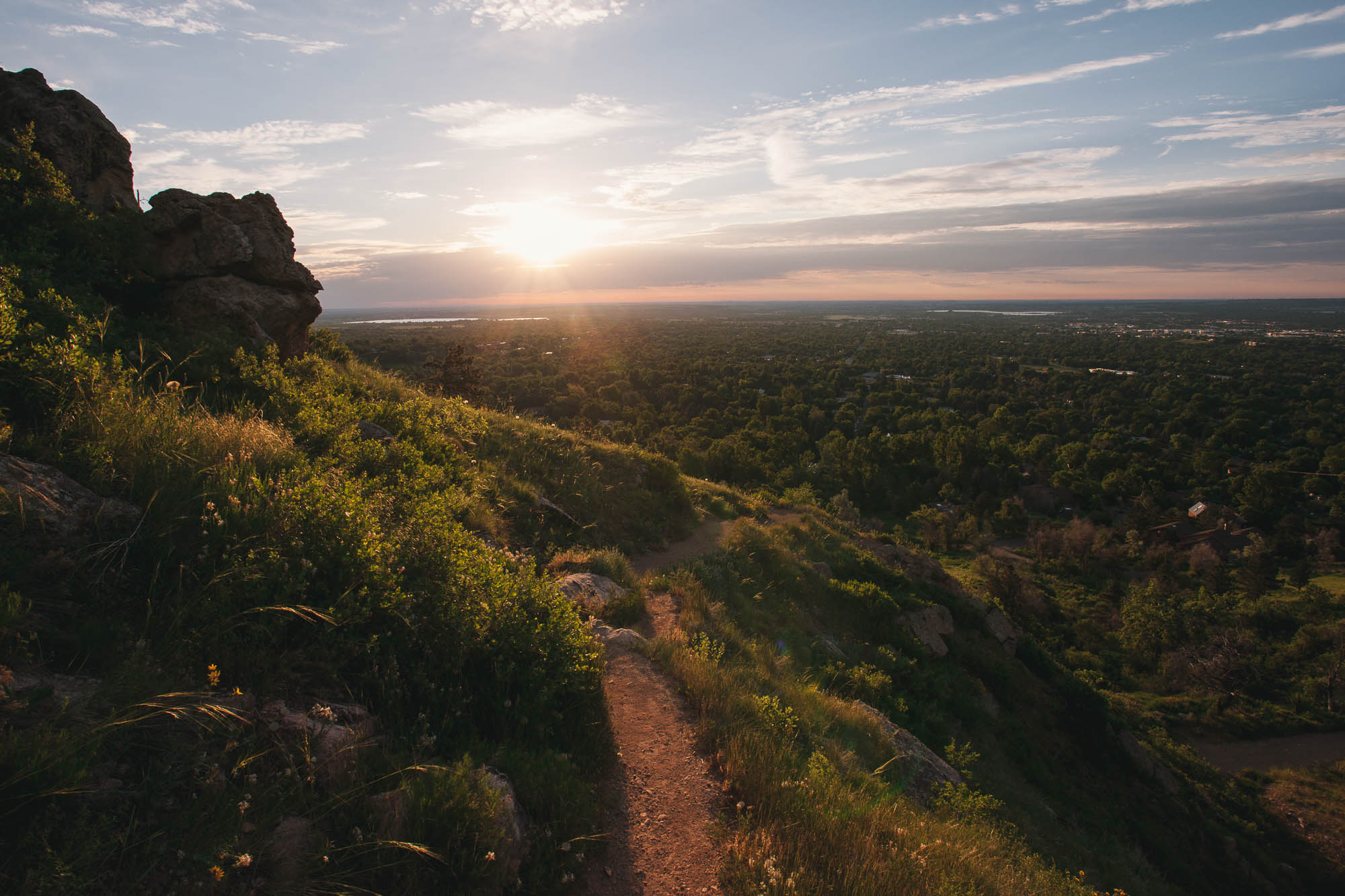It was about 7:00 pm when I arrived to downtown Boulder in late June of 2017.
I noticed a crowd of people standing around an area where police tape had cordoned off the majority of 16th Street between Pearl and Spruce. I stopped for a moment to digest the scene, and quickly dipped under the tape after determining where I needed to go. As I greeted the wildlife officers and volunteers, I looked up into a tree and found what I was looking for: a two year-old black bear nervously pacing around. This bear was having a very bad day; he was going on his fourteenth hour stuck in a tree, surrounded by humans. Between this tree being just one block north of the bustling Pearl Street Mall and an article posted by the Daily Camera which shared the bear’s location, hundreds of bystanders had made their way over to the area throughout the day to catch a glimpse of the bear.

Bearsitters keeping watch while bystanders admire the black bear. Photo courtesy of bearsitter volunteer, Karen Goodwin
I was there as a Colorado Parks and Wildlife volunteer bearsitter. My job was to keep the bear in the tree until the sun went down, and to assist with crowd control. I had bearsat numerous times before, but this was by far the most challenging due to the large crowd of people forming that didn’t quite understand what we were doing. People yelled things like, “leave the bear alone!,” “just let the bear come down!,” and “don’t kill the bear!” Meanwhile, this poor animal was stuck in a tree without any food or water, surrounded by humans, loud noises, and tempting aromas from downtown Boulder restaurants. The frustrated bear began moaning loudly, over and over, which in turn made me want to cry. We wanted to let the bear come down, but how could we do that with all these people gathered around? Didn’t they realize that if they simply left, we could let the bear go? There were numerous concerns to consider: with all the bystanders, he might run into someone and act aggressively, which could require the authorities to take lethal action. Or maybe he would get hit by a car as he tried to cross several busy intersections on his way back to the mountains. We were simply trying to prevent any of these negative scenarios from taking place.
Photo courtesy of bearsitter volunteer, Karen Goodwin


By the end of the day, we had six bearsitters, four wildlife officers, and two police officers on the scene.
The bear was getting restless, and despite all our efforts to keep him safely in the tree, we knew he was about to come down. The police officers began rerouting traffic so we could encourage the bear to go north on 16th street, and ideally back west to the mountains. Most people were very kind and respectful, but as the bear was preparing to come down, a few individuals refused to listen as we tried to clear the area. Despite our requests, two groups of people standing in the bear’s escape route refused to leave. Sure enough, the bear came down at 8:30pm, and as we hazed him towards Spruce Street with loud sounds and waving arms, he nearly ran directly into the group of people ignoring our requests, and was almost hit by an oncoming car. It was a foot race after that, and though he did go north like we wanted, he instead chose to run further east into Boulder, through an area that had unsecured trash cans and other tempting attractants.
We found him a few blocks away, back up a tree in a person’s backyard. The bear was clearly stressed and began groaning and hissing at us as we approached the tree. It was getting dark, and the wildlife officers decided we just needed to leave the area so the bear could come down on his own.
The hope was that this horrible day would leave quite an impression on this bear, which would encourage him to steer clear of Boulder’s urban areas in the future. It wasn’t the bear’s fault; he was just following his instincts and trying to survive.
This incident left no doubt in my mind: we needed to find a way to increase local knowledge of urban wildlife and empower residents to adopt proactive efforts that would prevent episodes like this from happening in the future.

In a time of information overload and lost connections to nature, it’s a challenge to get people to take interest in matters such as wildlife and land conservation.
However, as human populations increase, our landscapes change too, with wild spaces becoming less abundant. As a result, conflicts with wildlife will grow as human communities continue to move further into wild habitats. Our urbanizing society has forgotten that we humans are a part of nature, and not separate from it. This disconnect between humans and nature is leading us into a time where the world’s wildlife species are going extinct at a significantly faster rate than for millions of years before. At an initial glance, this sixth mass extinction may not seem to have any effect on human populations, but in reality, this requires our utmost attention as each and every one of us relies on the life-supporting systems that nature provides us, like clean air, fresh water, and nutrient-rich soils and pollinating species that produce sustainable foods and resources.
As a way to cut through the noise and encourage people to pay attention to and take action on behalf of wild nature, I focus on Boulder’s efforts to coexist with local black bears (Ursus americanus). By focusing on one identifiable species and region, I hope to demonstrate how the use of proactive community efforts and visual communication may produce greater willingness among residents to prevent negative interactions with wildlife, which may result in heightened wildlife protection and community safety.
It’s up to us, the community, to protect our local wildlife. Let’s get to work!
